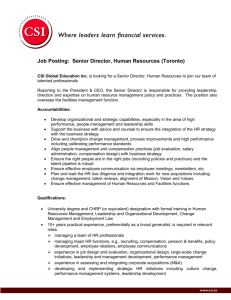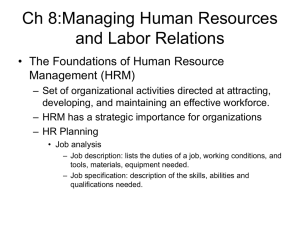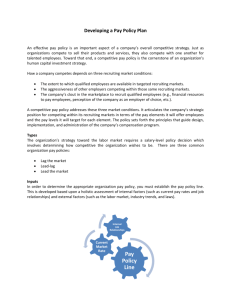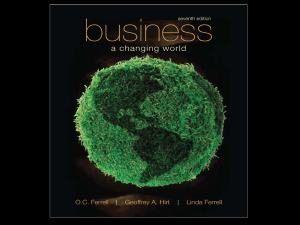CHAPTER 16: Human Resource Management
advertisement
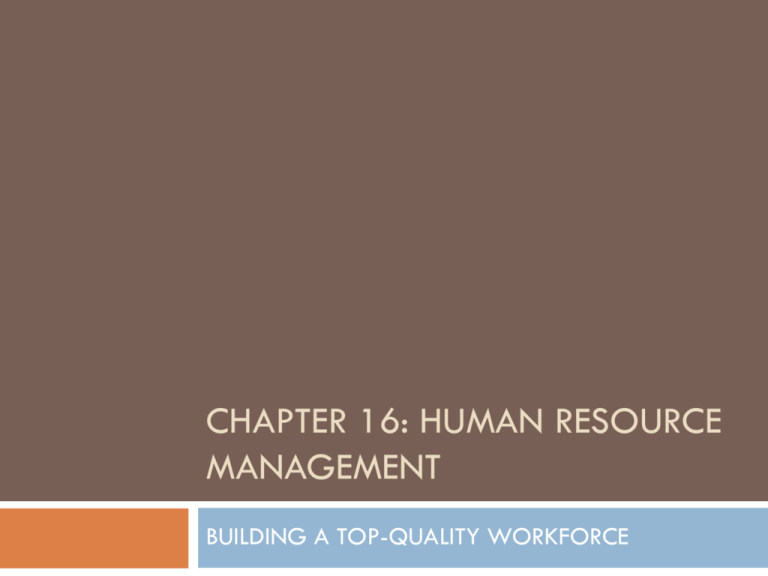
CHAPTER 16: HUMAN RESOURCE MANAGEMENT BUILDING A TOP-QUALITY WORKFORCE HUMAN RESOURCE MANAGEMENT: BRINGING BUSINESS TO LIFE Human Resource Management – maximizing the effectiveness of the workforce. Recruiting world-class talent Promoting career development Boosting organizational effectiveness HUMAN RESOURCE MANAGEMENT CHALLENGES: MAJOR HURDLES Older Workers Younger Workers Women Workers Need for Flexibility Wage Gap Outsourcing Lawsuits HUMAN RESOURCE MANAGERS: CORPORATE BLACK SHEEP? Problem: HR is often unprepared to make strategic decisions Daunting perception problems Solution: HR must gain respect and recognition for their role Focus on raising value of firm’s human capital Senior management must recognize role of HR HUMAN RESOURCE PLANNING: DRAWING THE MAP ANALYZING HUMAN ASSETS Job Analysis What skills does the workforce already have? What skills do they need? Job Description Job Specifications Teach 5 business classes A master’s degree in business Consult with students for 5 hours A minimum of three years business Participate in college governance Excellent interpersonal and communication skills Once you’ve decided on the skills you need to fill the job, where do you go to find the right person for the job? RECRUITMENT: FINDING THE RIGHT PEOPLE Internal Recruiting – transferring or promoting employees within the company. Boosts Morale Proven Track Record Lower Recruiting Costs RECRUITMENT: FINDING THE RIGHT PEOPLE External Recruiting – looking for employees outside the firm. Recruiting Resources: • Employment Websites • Newspaper Ads • Trade Associations • Employment Centers • Colleges/Universities Frogjobs.net FINDING THE RIGHT PEOPLE Swedish firm IKEA recently recruited young employees by posting handwritten ads on the walls of public bathrooms IKEA claimed that each ad was 4 - 5 times more effective than a standard newspaper ad, and a lot less expensive. There’s nothing like a captive audience! •(Source: Three ways to find generation Y by Eric Chester, Sept 2003, Workforce Management Online, http://www.workforce.com/archive/article/23/51/81.php) SELECTION: MAKING THE RIGHT CHOICE Resume Application Interviews Testing References and Background Checks STRUCTURED INTERVIEW Develop a list of questions prior to interview Focus questions on behaviors and experiences Describe a time when you… What would you do if… If you realized that a co-worker… INTERVIEW GAFFES: THINGS NOT TO DO “What five or six adjectives best describe you?” “Really, really, really, really, really cool!” “Were you late because you got lost?” “No. It was such a nice day that I didn’t mind driving slowly.” “Why should I hire you?” “Because they say you should always hire people better than yourself.” “What do you find interesting about this job? “The money. I don’t really care what your company does.” “How would you define a ‘problem person’?” “Anyone who disagrees with me.” JOB OFFERS & CONTINGENT WORKERS It is important for managers to set a probationary period with new hires Typically 3 to 6 months Employees will become permanent if everything works out Companies with fluctuating employment needs may opt to hire contingent workers Temporary Full-Time Independent Contractors On-call Workers TRAINING AND DEVELOPMENT: HONING THE COMPETITIVE EDGE Increase innovation Increase technology adoption Increase productivity Increase motivation Decrease liability ORIENTATION Effective orientations are the first step in the development process Introduce employees to the company culture Strong orientation programs reduce employee turnover TRAINING THE DISNEY WAY The Walt Disney Company requires all new employees to attend their “Disney University” orientation program. Their goal is “to engage employees on an emotional— not just intellectual—level.” They say, “We don’t put people in Disney. We put Disney in people.” Videos, storytelling, décor, and other techniques are designed to communicate the Disney magic. ON-THE-JOB TRAINING On-the-Job Training – popular and low cost employees simply begin working under the guidance of experienced employees. Apprenticeships –training programs where beginners serve as an assistant prior to working. OTHER TRAINING OPTIONS Off-the-Job Training – training that takes place away from the job setting. Companies employ a variety of training strategies: • Vestibule Training • Classroom • Job Simulations Computer-Based Training – standardized presentations using video, audio and broadband technology. Management Development – programs to assist current and potential executives develop leadership skills. NIKETOWN ONLINE TRAINING E-learning program called SLU Sports Learning Underground Designed like a subway map Product knowledge in 3-7 minute segments Quizzes and feedback Sales at stores with SLU training soared 4-5% EVALUATION: ASSESSING EMPLOYEE PERFORMANCE Performance Appraisals Formal feedback Compare actual to expected results May impact compensations, incentives, promotions, transfers and terminations HR should create an evaluation tool that ties into the company’s objectives Evaluation should be a feedback PROCESS Managers should be trained Employees should be informed of the process APPRAISAL GOOFS Gotcha! The Once-a-Year-Wonder Straight from the Gut What Have You Done for Me Lately? The “Me” Filter (Bias) COMPENSATION: SHOW ME THE MONEY Compensation – the combination of pay and benefits. Wages – pay in exchange for the number of hours or days that an employee works. Salary – the pay that employees receive over a fixed period. Benefits – noncash compensation like health care and vacation. VARIABLE PAY Commission Bonuses Profit Sharing Stock Options Pay for Knowledge BENEFITS: FROM BIRTHDAY CAKES TO DEATH BENEFITS Legally Mandated Benefits Social Security Medicare Contributions Unemployment Payments Workers’ Compensation Federal Family and Medical Leave Optional Benefits Paid Vacation & Holidays Paid Sick Days Health Insurance Retirement Programs Product Discounts Tuition Reimbursement CAFETERIA-STYLE BENEFITS Providing employees a set dollar amount per person that they spend on company benefits. Allows employees to tailor their benefits to their individual needs. EMPLOYEE HEALTH AND WELLNESS PROGRAMS “ According to the World Health Organization, every dollar spent on wellness programs saves three dollars in medical costs. Workplace fitness programs reduce short-term leave by up to 32% and increase productivity by up to 52%. “ (Source: Share the bottom-line benefits by Sid Kirchheimer, Time magazine, February 14, 2004) FLEXIBLE SCHEDULING Flextime Compressed Workweek Telecommuting BENEFITS AND DRAWBACKS OF TELECOMMUTING BENEFITS DRAWBACKS Organization Lower costs for office space Higher employee productivity Access to a broader talent pool Challenge maintaining company culture Greater challenges fostering teamwork Greater challenges monitoring and managing employees Employee Much more flexibility Zero commute time Better work-family balance Every day is casual Friday Fewer office politics Less career potential Less influence Weaker connection to company Isolation from the social structure SEPARATION: BREAKING UP IS HARD TO DO Employees will leave for a variety of reasons Fired Laid Off Transfers Career Changes Personal Reasons Employers should proceed carefully to avoid wrongful termination lawsuits TITLE VII: CIVIL RIGHTS ACT OF 1964 Prohibits discrimination in hiring, firing, compensation or privileges of employment based on race, color, religion, sex or national origin Supplemented with legislation to cover age, disability and pregnancy Title VII created the Equal Employment Opportunity Commission (EEOC) LEGAL ISSUES: HR AND THE LONG ARM OF THE LAW Fair Labor Standards Act of 1938 Equal Pay Act of 1963 Occupational Safety and Health Act of 1970 Immigration Reform and Control Act of 1986 Americans with Disabilities Act of 1990 Family and Medical Leave Act of 1996



